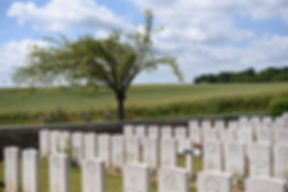


Guards Cemetery, Windy Corner
1 Old Bristolian
Guards Cemetery, Windy Corner (CWGC, 2016)
A little west of the crossroads known to the army as 'Windy Corner' was a house used as a battalion headquarters and dressing station. The cemetery grew up beside this house. The original cemetery is now Plots I and II and Rows A to S of Plot III.
It was begun by the 2nd Division in January 1915, and used extensively by the 4th (Guards) Brigade in and after February. It was closed at the end of May 1916, when it contained 681 graves. After the Armistice it was increased when more than 2,700 graves were brought in from the neighbouring battlefields - in particular the battlefields of Neuve-Chapelle, Aubers Ridge and Festubert - and from certain smaller cemeteries, including:- BALUCHI ROAD CEMETERY, NEUVE-CHAPELLE, on the road from Pont-Logy to the "Moated Grange". It contained the graves of fifteen soldiers from the United Kingdom who fell in the winter of 1914-15. EDWARD ROAD CEMETERY No.3, RICHEBOURG-L'AVOUE, on the South side of the Rue des Berceaux, near another "Windy Corner" (Plot I only, which contained the graves of five men of the 1st East Surreys who fell in October 1914).
INDIAN VILLAGE NORTH CEMETERY, FESTUBERT, near the intersection of "Prince's Road" and the front line of early 1915. It contained the graves of fifteen soldiers from the United Kingdom who fell in May and July 1915. LORGIES COMMUNAL CEMETERY, which contained two British graves of October 1918. PONT-FIXE SOUTH CEMETERY, CUINCHY, on the West side of "Harley Street" (the road going South from Windy Corner), a little South of the Canal. This was a row of graves stretching Westward behind houses, and contained the bodies of 42 soldiers from the United Kingdom who fell in 1915.
Guards Cemetery now contains 3,445 burials and commemorations of the First World War. 2,198 of the burials are unidentified but there are special memorials to 37 casualties known or believed to be buried among them.
Other special memorials commemorate six casualties buried in Indian Village North Cemetery, whose graves were destroyed by shell fire, and four Indian soldiers originally buried in the Guards Cemetery but afterwards cremated in accordance with the requirements of their faith. The cemetery was designed by Charles Holden.
Casualties
VIII. J. 14.
Born 12/04/1875
School 1886-1888
Served as a Captain in the East Surrey Regiment 3rd Bn.
Died 18/05/1915 Festubert, France.
Parents: Alfred and M. A. Hutton Williams; husband of Violet Woodfall Hutton Williams, of Holcombe, Caterham Valley, Surrey.
Bedfordshire Regiment, attd. 2nd Battalion
Fellowship details: No.4499, elected 21 December 1904.
Biography:
William Hutton Williams, eldest son of Alfred and M A Hutton Williams, was born in Clifton, Bristol in 1875. A mining engineer, Williams had studied at the Royal School of Mines between 1901 and 1904, thereafter working in Korea, Southern Manchuria and India before receiving his commission as captain in the East Surrey Regiment (3rd Bn). He was killed in action near Festubert, France on 18 May 1915.
Cemetery:
Guards Cemetery, Windy Corner, Cuinchy, Pas de Calais, France.
Bibliography:
-
Obituary, ‘The Times’, 26 May 1915.
-
Obituary, ‘Quarterly Journal of the Geological Society’, vol 72 (1916), Proceedings p lxiv.
1914/15 Star
Given the information we have available, it is very possible that William Hutton Williams was was awarded the 1914-15 star campaign medal of the British Empire for his service in World War One.
This Star is identical to the 1914 Star in every respect except that the centre scroll bears the dates “1914- 15” and the two small scrolls bearing “Aug” and “Nov” are omitted.
He would also have received the British War Medal and Victory Medal, as it was not awarded singularly. These three medals were sometimes irreverently referred to as Pip, Squeak and Wilfred. With Pip representing either this medal or the 1914 Star, only one of which could be awarded to a soldier, Squeak represented the British War Medal and Wilfred represented the Victory Medal. Buy Medals
Victory Medal
Given the information we have available it is likely that William Hutton Williams was entitled to the Victory medal, also called the Inter Allied Victory Medal. This medal was awarded to all who received the 1914 Star or 1914-15 Star and, with certain exceptions, to those who received the British War Medal. It was never awarded alone. These three medals were sometimes irreverently referred to as Pip, Squeak and Wilfred.
Eligibility for this award consisted of having been mobilised, fighting, having served in any of the theatres of operations, or at sea, between midnight 4th/5th August, 1914, and midnight, 11th/12th November, 1918. Women who served in any of the various military organisations in a theatre of operations were also eligible. Buy Medals
British War Medal
From the information available to us, it is very possible that William Hutton Williams was entitled to the British War Medal for service in World War One. This British Empire campaign medal was issued for services between 5th August 1914 and 11th November 1918.
The medal was automatically awarded in the event of death on active service before the completion of this period. Buy Medals
Deaths.
The Times (London, England), Wednesday, May 26, 1915; pg. 1; Issue 40864. (3201 words)
Category: Deaths
© Times Newspapers Limited
Gale Document Number:CS17237178




